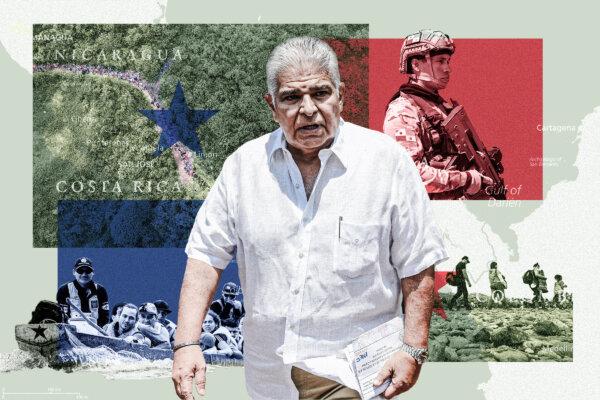EAGLE PASS, Texas—Benny Rodriguez, an 80-year-old grandfather of seven, beams as he points to faded photographs on the wall and proudly narrates the story of Eagle Grocery, a family-run business since 1939.
It withstood a fire in 1948. It emerged from a flood in 1954. And since 2002, the 11,000-square-foot store has persevered in the shadow of a 218,000-square-foot Walmart Supercenter two miles away.
“We’ve been through a lot, but we’re still here, and we love it; we love our community, and that’s what keeps us going,” Mr. Rodriguez told The Epoch Times inside the grocery at Main and Adams Streets.
But there are new worries about a recurrent threat that Eagle Grocery, the Rodriguez family, and the local economy have faced over the years.
In attempting to halt illegal crossings, federal officials have sometimes blocked the flow of law-abiding Eagle Grocery shoppers by blocking the legal ports of entry across the border bridges from Mexico.
That has hurt this shop’s bottom line, but the problem isn’t local. American businesses in border towns from California to Texas suffer when legal ports of entry are blocked, often as a political show of force in response to a surge in illegal crossings.
The last time the legal port of entry was blocked, the economy of Eagle Pass suffered a half-million-dollar loss in just a few weeks, its fire chief, Manuel Mello III, said.
“If this continues, we will have to place a freeze on hiring personnel, purchasing equipment, and completing projects for our citizens,” he testified to Congress during a January hearing on illegal immigration.
Similar unintended consequences are playing out in many U.S. border towns. And the collateral damage is rippling across America in ways that most people don’t realize, draining tens of thousands of jobs and billions of dollars in revenue.
Many Texans, including the Rodriguez clan, say this scenario provides more proof that many decision-makers are out of touch with the realities of life along the border. They hope for a fresh, commonsense antidote.

Beneficial Relationships
Mexico, the United States’ No. 1 trade partner, helped generate nearly $1 trillion in gross domestic product and at least 8 million jobs across America in 2023, according to a February report from The Perryman Group, a Texas-based firm that has analyzed U.S.–Mexico “Bordernomics” for many years.The fate of Eagle Pass, Texas, is intertwined with its Mexican sister city, Piedras Negras—typifying such relationships all along both sides of the border.
“They depend on us; we depend on them,” Mr. Rodriguez said. “If they don’t come over here, and we don’t go over there, everything stops.”
In 2016, he served as Eagle Pass’s “Mr. Amigo,” an honor bestowed upon one resident of each city for the annual International Friendship Festival. But in March, the illegal immigration crisis displaced the joint celebration from its usual home in Shelby Park.
That 47-acre Eagle Pass park sits alongside the Rio Grande, the river separating the United States and Mexico. For months, it has remained closed amid a standoff between federal and state authorities who disagree over how to enforce immigration laws and control the U.S. border.
Texas Gov. Greg Abbott is among the many Republicans who accuse President Joe Biden of promoting open-border policies; Mr. Abbott emphasizes stringent enforcement of immigration laws and construction of border barriers. The White House has advocated “a fair, orderly, and humane immigration system” while calling on Congress to “make long overdue reforms to U.S. immigration laws.”
That clash—and unprecedented numbers of illegal immigrants—thrust Eagle Pass, a city of about 30,000 people, into the national spotlight late last year.
Often called “La Puerta de México,” Mexico’s Door, Eagle Pass serves as the fastest route from Mexico to major Texas cities.
A pair of international bridges, simply called Bridge One and Bridge Two, connect Eagle Pass and Piedras Negras.

‘It Makes No Sense’
These illegal immigrant surges are unpredictable. CBP has sometimes responded by shutting down bridges leading from Mexico to the United States.As soon as the feds stopped passenger cars from crossing Bridge One in Eagle Pass on Nov. 27, 2023, “60 percent of our customer base was gone,” said Mr. Rodriguez’s wife, Angie.
Many Mexican nationals possess U.S.-issued cards permitting them to travel back and forth. Agents check those cards at legal ports of entry, such as the Eagle Pass bridges. These short-term visitors come into the United States to visit friends and family; they attend school, eat at restaurants, enjoy entertainment, and go shopping. Then they return to their homes in and near Piedras Negras.
These are the people whom the recent U.S. government border restrictions affected the most, the Rodriguez family’s eldest son, Jaime, 50, told The Epoch Times.
“So, you close the bridge to legal shoppers … to open the way for illegal people coming across under the bridge; it makes no sense,” Jaime Rodriguez said.
But that’s what happens “when you’re making decisions from Washington, D.C., without knowing the repercussions you’re having.”
The effects reverberate from Brownsville at Texas’s southernmost tip to the border’s end point in California, almost 2,000 miles away, he said.
Cargo Chaos
Three weeks into the bridge shutdown, The Texas Border Coalition, which pushes for “secure, efficient borders that facilitate legitimate trade and travel,” appealed to the Biden administration for relief.
Because the closures also affected railways, “the entire North American rail network” was suffering, the coalition said. Agricultural products, automotive parts, new cars, chemicals, and other goods languished.
One railroad was holding in limbo 60 trains in 50 different railyards, the group said; grain trains were stuck in “various locations throughout Illinois, Iowa, Minnesota, Nebraska, Missouri, and Kansas.” Similar snarls were also happening in Mexico with U.S.-bound cargo, the group said.
In announcing the closures, CBP said the action was needed to stop illegal immigrants’ dangerous practice of hitching rides atop railcars.
But “migrants are not using these well-controlled rail crossings in significant numbers,” the coalition’s release said, adding, “closing these rail gateways will not alleviate unauthorized crossings.”
Instead, the coalition said, closures would continue wreaking havoc on transportation and the economy.
Both Political Parties Have Failed
El Paso County Commissioner David Stout, a Democrat who chairs the nonpartisan coalition, said that, regardless of which U.S. political party is calling the shots, all illegal immigration-deterrent approaches have proven ineffective.Deterrents just push migrants from one illegal entry point to another, he said.
While in office, President Donald Trump, a Republican, repeatedly threatened to close the border or add tariffs to Mexican goods to halt illegal immigration, stoking fears of economic doom in 2019.
The most effective initiative the Trump administration introduced to decrease illegal immigration was the Remain in Mexico program, which forced illegal immigrants to wait in Mexico until their case was adjudicated in U.S. immigration court.
President Trump didn’t close the border until March 2020, when he enacted the Title 42 health-related emergency measure due to COVID-19. In an effort to curb the virus, the U.S. government cut off all “nonessential travel” between Mexico and the United States and Canada and the United States. The ban lasted 20 months, until the Biden administration lifted it in November 2021.
The Rodriguezes believe that President Trump wouldn’t have closed the border otherwise.



“The Mexican nationals, who are just going to go back home, he welcomes their dollars,” Jaime Rodriguez said, “because he’s a businessman.”
Overall, the Rodriguezes said they felt that President Trump’s policies seemed to be more effective at curtailing illegal immigration while supporting legal commerce.
Although President Trump attracted the most attention for adding miles to the U.S.–Mexico border wall, virtually all presidents since the 1980s have added to it.
President Biden almost broke that trend. He halted wall construction on his first day in office and vowed he wouldn’t build another foot of new wall; his administration sold border-wall construction materials that the Trump administration had purchased.
But last year, under pressure as illegal immigration spiked, President Biden changed his stance. Using presidential powers, he waived 26 federal laws and authorized construction of 20 miles of border wall.
Building more miles of wall is likely to be “a waste of money and resources,” Jaime Rodriguez said. That’s because, by the time people are caught approaching or climbing the much-debated wall, they’re already on U.S. soil.
“Once they step here, you’ve got to welcome them into your country,” Jaime Rodriguez said. That’s because, by law, authorities have no choice but to “welcome” the illegals. Eagle Pass’s wall sections sit a half-mile inland from the borderline dividing the Rio Grande; the U.S. Supreme Court has held that, once illegal immigrants set foot on U.S. territory, they’re entitled to due process under the Constitution.
That’s why Jaime Rodriguez thought President Trump’s proposed plan to erect a floating barrier in the middle of the river might thwart migrants’ river-crossings before they cross into the United States.


Texas state officials ran with the floating barrier idea last year, despite opposition from immigrant advocates who considered the apparatus risky.
And the Biden administration sued to seek removal of the 1,000-foot strip of concrete-weighted buoys, citing legal, environmental, and humanitarian concerns. That case remains pending in federal courts.
Meanwhile, Presidents Biden and Trump are criticizing each others’ border policies on the campaign trail, as pressure mounts for Congress to take more decisive action.
Mr. Stout, who holds a master’s in Latin American studies and heads an immigration-reform task force for the National Association of Counties, said he has talked to people of all political persuasions and they seem to agree on a few points.
Over many decades, migration trends have ebbed and flowed, creating hotspots that shift from one place to another. “But, you know, people are not going to stop coming; the deterrence-only policies have not worked,” he said. “We need to do something different if we actually want to solve the problem.”
At times, he wonders whether officeholders lack the will to fix immigration because it’s political red meat for their bases.
Mr. Stout and Jaime Rodriguez both said that an updated version of the Bracero Program could work. Under that program, from 1946 to 1964, the United States permitted Mexican laborers to enter and work for several months and then return home.
Jaime Rodriguez says the people he and his parents talk to “aren’t that strong to identify as a true Democrat or a true Republican.”
“We identify with the issues and the situation that our nation is in,” he said. “We need a change. We need some help. We need some stability.”

















